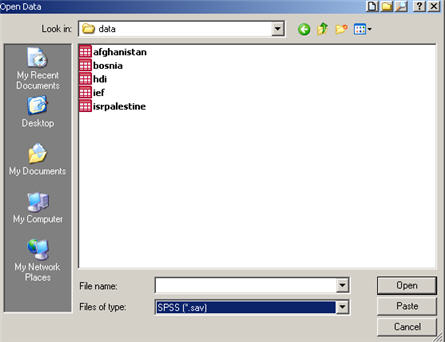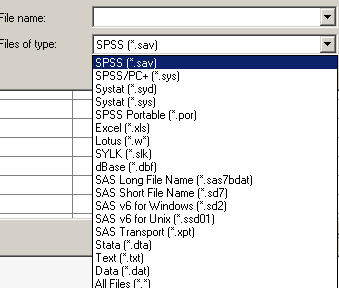The menu lets you access data in many different formats.
By default it reads SPSS Data files (SAV files, SPSS standard system files),
i.e. data files created
by SPSS for use with SPSS.
 Default dialog, showing all files of the current file type, i.e. the default SPSS data file.
Default dialog, showing all files of the current file type, i.e. the default SPSS data file.
 SPSS can read many different formats: Select the appropriate file type:
SPSS can read many different formats: Select the appropriate file type:
- SPSS .sav file: is the default as explained above
- SPSS .sys file: Imports data from an early PC version of SPSS
- Systat files: Reads directly various forms of Systat files (Statistical package)
- SPSS .por file: Imports SPSS portable files (a special SPSS format that
can be read by all SPSS versions)
- Excel, Lotus SYLK are spreadsheet formats. Most data oriented software can read and write
at least one of these formats.
- Dbase reads Dbase (a data base management program) files. Note that this an old format, but still
used as a minimal standard, i.e. many data oriented software packages both read and write that format.
To access modern data bases, SPSS offers much more powerful
facilities (See )
- SAS reads various forms of SAS files (Statistical Package)
STATA reads STATA files (Statistical Package)
- Text, Data reads raw data files and will access the text wizard (same as selecting
)
- All files: Use with caution as SPSS only reads correctly file types listed above. This option might
be useful if your file does not have the correct extension.
.
Comments
- This menu combines in fact several SPSS commands, namely
the GET FILE command for reading SPSS files,
the GET TRANSLATE command for importing other
formats and the DATA LIST command for reading
in raw data.
Related documents
 Default dialog, showing all files of the current file type, i.e. the default SPSS data file.
Default dialog, showing all files of the current file type, i.e. the default SPSS data file.
 Default dialog, showing all files of the current file type, i.e. the default SPSS data file.
Default dialog, showing all files of the current file type, i.e. the default SPSS data file.
 SPSS can read many different formats: Select the appropriate file type:
SPSS can read many different formats: Select the appropriate file type: